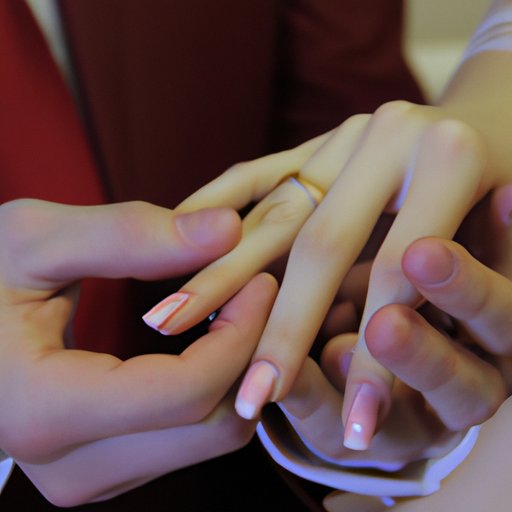Which Hand Is the Wedding Ring: A Comprehensive Guide
When deciding which hand to wear a wedding ring on, couples may encounter a variety of myths, misconceptions, and cultural traditions that can make the decision a difficult one. From the belief that there is a vein connected to the heart in the left-hand ring finger to the idea that wearing the ring on the right hand is bad luck, couples can end up feeling confused and overwhelmed.
This article aims to provide historical, cultural, and practical information to help couples make an informed decision about which hand to wear their wedding ring on. By exploring the rich history and cultural significance of wedding rings, analyzing trends and variations around the world, and offering a unique perspective from couples who have chosen non-traditional ways of wearing their rings, this article seeks to guide couples towards the choice that best reflects their personal preferences and values.
The History and Cultural Significance of the Wedding Ring
The tradition of exchanging rings in marriage ceremonies has roots that date back to ancient times. Egyptians, Greeks, and Romans all exchanged rings as a symbol of love and commitment, and the rings themselves were often engraved with intricate designs and symbols. Over time, the practice of wearing wedding rings evolved, with many cultures eventually settling on the left-hand ring finger as the ideal placement.
One theory behind this tradition is that the left-hand ring finger contains a vein that runs directly to the heart, known as the ‘vena amoris’ or ‘vein of love.’ This belief has been debunked by modern science, but it continues to be a popular notion that gives the left-hand ring finger added significance.
While the practice of wearing wedding rings on the left hand has become widely accepted in Western cultures, other parts of the world have developed their own traditions. Some cultures prefer the right hand for wedding rings, while others have specific customs that dictate the number or design of the rings.
Addressing Common Misconceptions and Myths
There are a number of myths and misconceptions surrounding the placement of wedding rings, and many of these beliefs can cause confusion for couples trying to decide which hand to wear their rings on.
One of the most persistent myths is that the left-hand ring finger is directly connected to the heart by a vein. While it is true that the finger does contain a vein that runs to the heart, this vein is present in all fingers and has no special significance. Another common myth is that wearing a wedding ring on the right hand is bad luck, an idea that has no basis in fact or history but has been perpetuated by tradition.
Other myths surrounding wedding rings include beliefs that the ring should be removed during pregnancy, a superstition that likely stems from concerns over swelling and discomfort, and the idea that the ring should only be worn by women, a notion that is thankfully losing ground in modern times.
Providing Practical Advice for Couples
When it comes to deciding which hand to wear a wedding ring on, there are several practical factors that couples may want to consider. Depending on cultural traditions and personal preferences, couples may also wish to weigh the symbolism associated with different fingers.
For example, in some cultures, the index fingers are considered the best place for wedding rings because they are associated with power and authority. In other cultures, wearing rings on the ring finger of the right hand is seen as a sign of independence and self-reliance.
When it comes to practical concerns like comfort, work, and safety, couples may prefer to wear their rings on a hand that is less likely to get snagged or caught. For those who work with their hands, wearing a ring on the non-dominant hand may be a better choice to minimize the risk of damage or injury.
Analyzing Trends and Variations in Different Countries and Cultures
While the practice of wearing wedding rings is widespread, different cultures have developed their own traditions surrounding this symbolic item. In some countries, the design and style of the ring are heavily influenced by cultural or religious symbols, while in others, wearing more than one ring is common.
One example is Russia, where couples often wear wedding rings on their right hand rather than their left. In Germany and the Netherlands, rings are sometimes worn on the left hand during the engagement period, then shifted to the right hand after the wedding. In some parts of South America, engagement rings are worn on the right hand, while wedding rings are worn on the left.
Offering a Unique Perspective from Couples
To gain a better understanding of the range of options available when it comes to wearing wedding rings, it can be helpful to hear directly from couples who have made this decision themselves. Some couples choose to wear their rings on non-traditional fingers or hands, while others opt for unique designs or unconventional materials.
For example, one couple may choose to wear their wedding rings on the pinky fingers as a nod to their shared love of fashion, while another couple may opt for matching wrist tattoos instead of rings. These choices reflect not only personal preferences but also the unique qualities of the relationship and the values that the couple holds dear.
Conclusion
When it comes to choosing the right hand for a wedding ring, there is no one-size-fits-all answer. By exploring the rich history and cultural significance of wedding rings, addressing common myths and misconceptions, providing practical advice for couples, analyzing trends and variations around the world, and sharing unique perspectives from couples themselves, this article seeks to empower couples to make a decision that best reflects their personal preferences and values.
